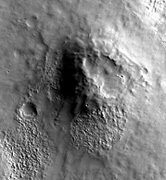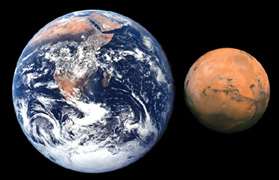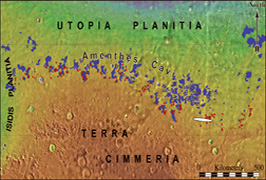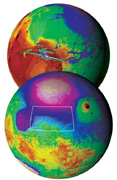|
Science
Above left: Image on Mars of several, small-diameter pitted cones and domes. This image represents a scale of approximately 3.5 km wide. Image: Mars Orbiter Camera (MOC) Instrument team NASA/Malin Space Science Systems. See MSSS.com. Above middle: Image on Mars, showing a positive-relief, crater-like feature. Image is approximately 15 km wide. Image: High Resolution Imaging Science Experiment (HiRISE) Instrument Team, NASA/University of Arizona. See HIRISE.lpl.arizona.edu). Above right: Image on Mars of two crater-like features
with associated flows. Area is covered by small impact craters.
Image is approximately 15 km wide. Image: Thermal Emission Imaging
System (THEMIS) Instrument Team, NASA/Arizona State University.
See THEMIS.asu.edu.
Above left: Earth and Mars, comparison of size and substance. Satellite image. Above right: This image shows a region of Mars' surface that contains features of postulated mud volcano-like vents, flows, and surface deformations. The region is located along a globe-encircling scarp that separates the Martian highlands from the lowlands. The putative mud volcano-related terrains lie between ancient, impact-scarred high plateaus of Terra Cimmeria (to the south) and low-lying, nearly-horizontal plains of Utopia and Isidis Planitia (to the north and west, respectively). While small magma volcanoes are common on Mars, they tend to cluster near large volcanic regions and their associated faults. However, the putative mud volcanoes, some of which are noted in this image, are widespread and are interpreted to be more closely associated with sedimentary basins, than with magma-related volcanic centers. A recent study of this region
mapped out potential mud-related surface cracks, flows, and depressions
(blue areas) and cone-and mound-shaped mud volcano-like vents
(red dots). Because such regions can help geologists unravel
the history of the Red Planet, including whether life once existed
there, NASA considered this area as a landing site for its Mars
Exploration Rovers. The white ellipse shows the location of the
candidate landing zone.
Above left: Mud volcanoes in Azerbaijan, Landsat TM image, excerpted by K. H. Scholte, Delft University of Technology. Above right: Turaghay Volcano, Azerbaijan's largest mud volcano (400m high). In relationship to this investigation, we are especially keen to go to Azerbaijan and study the mud volcanoes there because what is known as classically-formed mud volcanoes is so easily accessible there. Another reason why Azerbaijan makes for an ideal study is that vegetation is sparse on the mud volcanoes there, and that makes them easier to study and compare by remote-sensing observations (there are no shrubs on Mars!). Another advantage is that mud volcanoes remain active in Azerbaijan. Since Mars has undergone little erosion, we think that by studying active mud volcanoes on Earth, we can get a fresh look at the depositional characteristics of mud-flows and can selectively avoid regions that may have been severely altered by non-mud volcanic surface processes, such as rain-fed channels. There's one other major advantage for studying mud volcanoes in Azerbaijan. Because that region has such a large quantity of mud volcanoes, many geologists have scientific and logistical background knowledge that is critical to the success of a field-based comparative analog study for Mars. We have been in contact with scientists at the Geologic Institute of Azerbaijan in Baku, and hope to be able to cooperate together on such projects. Knowledge - What For? However, in a more practical sense, our studies can help shed light on Martian processes that are similar to terrestrial mud volcanism and provide a better understanding on ancient surface conditions that might have supported life. These scientific efforts may help select favorable landing sites for future exploration. _______ Back
to Index AI 15.1 |









